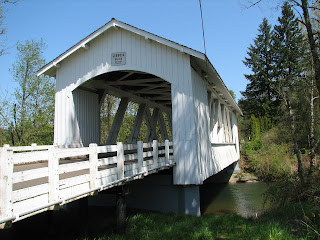Bridges, so the saying goes, are America’s cathedrals. They inspire a range of emotions from awe to pride, but no bridge generates more affection than the humble, country, covered bridge. While most of these bridges are concentrated in the eastern states of New England, Pennsylvania and Ohio, Oregon can claim the number five spot and proudly boast of having the largest collection of covered bridges west of the Mississippi. Oregon’s tradition of bridge building dates back to 1851, when the first one was constructed in Oregon City. With the state’s vast forests of Douglas fir, wood was the obvious and logical building material, but not necessarily the best. A wooden plank bridge deck might last about eight or nine years before succumbing to the damp Northwest climate. On the other hand, one covered in a house frame to protect the deck and large timber trusses from the elements, could survive ten times longer. Soon covered bridges dotted the countryside, particularly in the Willamette Valley and southern timber counties. By the early part of the 1900s, the state was home to over 450 covered bridges.
Over time, however, new construction materials like steel, iron, and concrete made the wood bridges obsolete. The cost of maintaining these structures grew so dramatically that county and state highway departments chose to replace them with concrete spans. Many were dismantled and destroyed. Today, only 50 bridges remain in the state, largely through the efforts of local historical groups and the Oregon state legislature which provided funding for their preservation.
A good place to view a variety of these remaining links to the past is the small town of Scio, about 25 miles southeast of Salem in Linn County. Scio bills itself as “The Covered Bridge Capital of the West” and has five bridges within a ten mile radius, most of them spanning Thomas Creek The most colorful of the lot is the Shimanek Bridge, painted bright red with a white trim on its Gothic-style, louvered windows. Built in 1966, it is the area’s newest bridge replacing four earlier ones destroyed in floods and storms.
Downstream, on the other side of Scio, is the Gilkey Bridge, dating back to 1936. Recently, the bridge experienced a run of bad luck. In 1997, an over-loaded vehicle stressed the bridge creating serious damage and forcing its closure for a year of extensive repairs. In 2008, a large, farm service truck smashed into the bridge causing damage to the roof and side-support timbers. Once again, the bridge had to be closed for repairs but is back in business now.
The bridge offering the most attractive setting is the Larwood Bridge in a county wayside park of the same name. Here the Roaring River flows into Crabtree Creek, creating a geographical phenomenon so unusual, i.e. river flows into creek, it made it into Ripley’s Believe It Or Not. A pleasant, shaded picnic area offers a fine view of the bridge, streams, and the remnants of an old water-powered mill.
The Hannah Bridge, also dating to 1936 and spanning Thomas Creek, has open walls and exposed beams, making it one of the most attractive. Finally, the Hoffman Bridge over Crabtree Creek was built mostly with hand tools and adz marks are still visible in the upper timbers.
To learn more about the area’s covered bridges, a visit to the Depot Museum (open weekends only) in Scio is a must. Located in the old train depot from West Scio, the museum houses a collection of historical items from local pioneer families and has a notebook of clippings and early photos of area bridges that have been destroyed or replaced. A brochure is available detailing a bicycle and driving tour that visits all the local bridges.






No comments:
Post a Comment